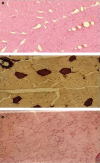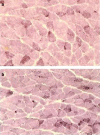Acetazolamide prevents vacuolar myopathy in skeletal muscle of K(+) -depleted rats
- PMID: 18345024
- PMCID: PMC2438991
- DOI: 10.1038/bjp.2008.42
Acetazolamide prevents vacuolar myopathy in skeletal muscle of K(+) -depleted rats
Abstract
Background and purpose: Acetazolamide and dichlorphenamide are carbonic anhydrase (CA) inhibitors effective in the clinical condition of hypokalemic periodic paralysis (hypoPP). Whether these drugs prevent vacuolar myopathy, which is a pathogenic factor in hypoPP, is unknown. The effects of these drugs on the efflux of lactate from skeletal muscle were also investigated.
Experimental approach: For 10 days, K(+)-depleted rats, a model of hypoPP, were administered 5.6 mg kg(-1) day(-1) of acetazolamide, dichlorphenamide or bendroflumethiazide (the last is not an inhibitor of CA). Histological analysis of vacuolar myopathy and in vitro lactate efflux measurements were performed in skeletal muscles from treated and untreated K(+)-depleted rats, and also from normokalemic rats.
Key results: About three times as many vacuoles were found in the type II fibres of tibialis anterioris muscle sections from K(+)-depleted rats as were found in the same muscle from normokalemic rats. In ex vivo experiments, a higher efflux of lactate on in vitro incubation was found in muscles of K(+)-depleted rats compared with that found in muscles from normokalemic rats. After treatment of K(+)-depleted rats with acetazolamide, the numbers of vacuoles in tibialis anterioris muscle decreased to near normal values. Incubation with acetazolamide in vitro inhibited efflux of lactate from muscles of K(+)-depleted rats. In contrast, bendroflumethiazide and dichlorphenamide failed to prevent vacuolar myopathy after treatment in vivo and failed to inhibit lactate efflux in vitro.
Conclusions and implications: Acetazolamide prevents vacuolar myopathy in K(+)-depleted rats. This effect was associated with inhibition of lactate transport, rather than inhibition of CA.
Figures




References
-
- Al-Aloul B, Li JM, Benditt D, Tholakanahalli V. Atrial fibrillation associated with hypokalemia due to primary hyperaldosteronism (Conn's syndrome) Pacing Clin Electrophysiol. 2006;29:1303–1305. - PubMed
-
- Banker BQ, Engel AG.Basic reactions of muscle Myology 2004McGraw-Hill Press: USA; 691–748.In: Engel AG, Franzini-Armstrong C (eds).3rd edn. Vol. 30
-
- Ciszowski K, Winnik L, Groszek B, Klys M, Kolodziej J. Acute chloroquine intoxication—rare, but always serious: case reports and literature review. Przegl Lek. 2005;62:501–507. - PubMed
-
- Clare BW, Supuran CT. A perspective on quantitative structure–activity relationships and carbonic anhydrase inhibitors. Expert Opin Drug Metab Toxicol. 2006;2:113–137. - PubMed
Publication types
MeSH terms
Substances
LinkOut - more resources
Full Text Sources
Medical

